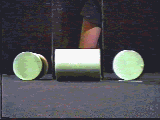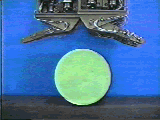

[RobotHandのページ]
[スケール依存型把握]
多指ロボットハンドで様々な大きさの対象物を把握するための把握戦略
This paper discusses the scale-dependent grasp. Suppose that an object is initially placed on a table without touching by human hand and, then he (or she) finally achieves an enveloping grasp after an appropriate approach phase. Under such initial and final conditions, human unconsciously changes the grasp strategy according to the size of object, even though they have similargeometry. We call the grasp planning the scale-dependent grasp. Focusing on column objects, we first classified the grasp patterns into a couple of grasps and extracted the essential motions so that we can apply the scale-dependent grasp to multi-fingeredrobot hands. We found that the grasp patterns should be also changed according to the surface friction and the geometry of cross section of object in addition to the scale. The basic strategies were verified by experiments. Finally, we considered how each strategy should be switched from one to another.
This paper discusses the scale-dependent grasps. Suppose that an object is initially placed on a table without touching by human hand and, then he (or she) finally achieves an enveloping grasp after an appropriate approach phase. Under such initial and final conditions, human unconsciously changes the grasp strategy according to the size of object, even though they have similar geometry. We call the grasp planning the scale-dependent grasp. Along the grasp patterns observed in human grasping, we apply a couple of grasp procedures to multi-fingered robot hands.